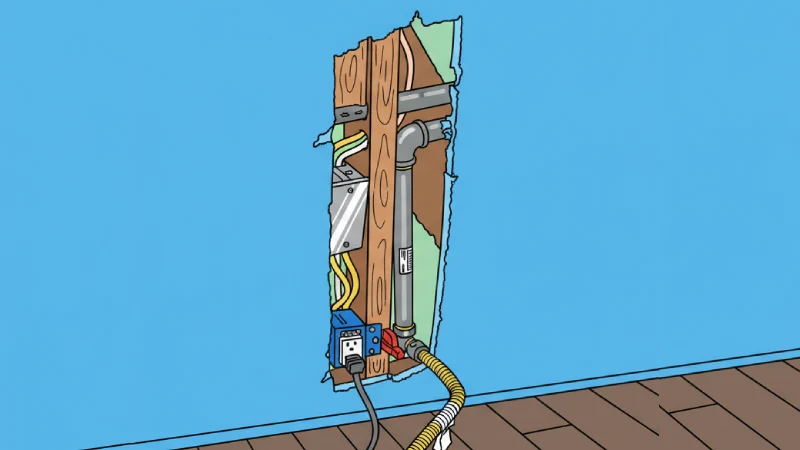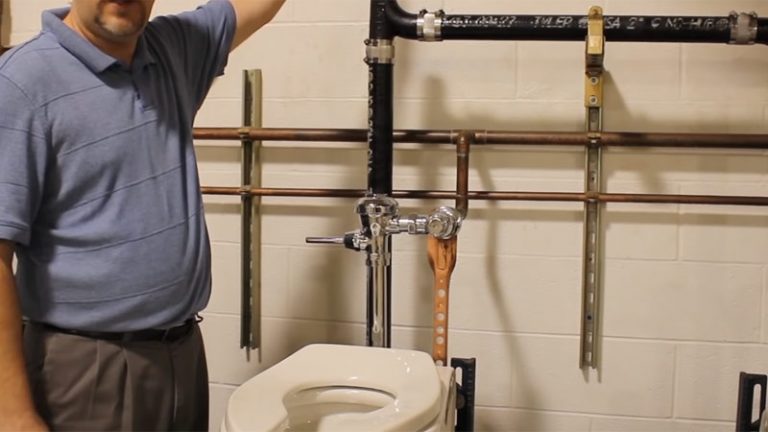Gas Line in Wall? What You Don’t Know Can Be Deadly
You’re planning a simple weekend project—maybe hanging a new flat-screen TV or putting up some shelves. As you map out the perfect spot, a nagging thought creeps in: what if there’s a gas line in the wall? It’s a common fear for homeowners, and for good reason. Accidentally puncturing a gas pipe can have catastrophic consequences.
But is it normal to have gas pipes running through interior walls? The short answer is yes, it’s a standard construction practice. However, these installations must follow strict safety codes to protect you and your family. Understanding the risks, regulations, and proper procedures is essential for your peace of mind.
You'll Learn About
Is It Normal to Have a Gas Line in a Wall?
It is perfectly normal and common for gas lines to be routed through walls, ceilings, and floors to reach appliances like furnaces, water heaters, stoves, and dryers. In modern construction, builders often run gas pipes through the same wall cavities that house electrical wiring and plumbing. Hiding these lines creates a clean, finished look in your home.
However, just because it’s common doesn’t mean it’s without rules. Professional plumbers and gas fitters must adhere to stringent building codes designed to prevent accidents. These codes dictate the type of pipe material that can be used, how joints must be sealed, and what protective measures are necessary to prevent punctures.
The Unseen Dangers: What Are the Real Risks?
While professionally installed gas lines are safe, the potential for danger is always present, especially in older homes or where work has been done without proper permits. The primary risk is a gas leak, which can lead to fires, explosions, and serious health hazards.
Natural gas is flammable and can ignite from a simple spark, like flipping a light switch or static electricity. Furthermore, a slow, undetected leak can lead to carbon monoxide (CO) poisoning, a colorless, odorless gas that can be fatal. This is why it’s crucial to take any suspicion of a gas leak seriously.
How to Identify a Potential Gas Leak
Natural gas is naturally odorless, so utility companies add a chemical called mercaptan to give it a distinct smell, often described as rotten eggs or sulfur. This is your primary warning sign. If you smell gas, do not hesitate.
Other signs of a leak include a hissing or whistling sound near a gas line or appliance, and dying plants near a suspected exterior leak. If you suspect a leak, immediately evacuate everyone from the house. Do not use your phone, turn on/off any lights, or use any electronics. Once you are safely outside and away from the property, call your gas utility’s emergency number or 911.
Know Your Pipes: Types of Gas Lines Used in Walls
Not all gas pipes are created equal. The material used for the gas lines in your walls depends on the age of your home, local codes, and the specific application. Understanding the different types can help you identify what you’re working with.
The three most common materials for residential gas piping are black iron, corrugated stainless steel tubing (CSST), and copper. Each has its own set of advantages and disadvantages regarding durability, flexibility, and installation requirements.

Black iron pipe is the traditional choice and is known for its strength and heat resistance. CSST is a more modern, flexible option that is easier to install in tight spaces. Copper is also used in some regions, but its use is often restricted by local codes.
| Pipe Material | Pros | Cons | Best For |
|---|---|---|---|
| Black Iron | Highly durable, heat-resistant, strong joints. | Prone to corrosion over time, labor-intensive installation. | Traditional and widely approved for interior and exterior use. |
| CSST (Corrugated Stainless Steel Tubing) | Flexible, easy to route through walls, fewer fittings needed. | Requires proper grounding, can be damaged if not protected. | Modern construction and retrofitting in complex spaces. |
| Copper | Resistant to corrosion, relatively easy to work with. | Not permitted in all jurisdictions, softer than steel. | Areas where it is explicitly allowed by local code. |
The Rulebook: Understanding Gas Line Codes and Safety Regulations
You cannot talk about a gas line in a wall without discussing building codes. These regulations are not just suggestions; they are legally enforceable rules designed to ensure safety. While codes can vary by municipality, some universal principles apply.
One critical requirement is the use of nail plates. These are small steel plates installed on the face of wall studs wherever a gas pipe passes through. Their job is to protect the pipe from being accidentally pierced by nails or screws during drywall installation or future renovations.
Another key rule is that certain types of fittings, like unions, are often prohibited inside a concealed wall space. This is because these fittings are more prone to leaks than a solid run of pipe or a welded joint. All work must be pressure-tested and inspected before the walls are closed up to ensure the system is airtight.
DIY Disaster: Why You Should Never Tamper with Gas Lines
Working with gas lines is not a DIY project. The risks are simply too high. Attempting to move, cap, or repair a gas line without the proper training, tools, and permits can lead to disaster. It can also void your homeowner’s insurance and create significant legal liability.
Even seemingly unrelated tasks can pose a threat. Before you start patching a hole, consider the materials you’re using. You might wonder, is spackle toxic? While that’s a valid concern for air quality, puncturing a hidden gas line is a far more immediate danger. Always hire a licensed and insured plumber or gas fitter for any work involving your gas system.
The Big Project: Moving or Removing a Gas Line in a Wall
Remodeling your kitchen or laundry room often requires relocating appliances, which may mean moving a gas line. The cost to move a gas line can range from $250 to over $1,000, depending on the complexity of the job. Factors influencing the cost include the distance the pipe needs to move, the type of pipe material, and the accessibility of the work area.
The process involves shutting off the main gas supply, safely venting the existing line, cutting and rerouting the pipe, and then pressure testing the new configuration. This is a multi-step process that requires professional expertise. For instance, if you are remodeling your kitchen, you might consider the cost to convert gas stove to electric as an alternative to moving a gas line, but this too involves professional work by both an electrician and a plumber to cap the line safely.
What If I Need to Cover or Hide an Exposed Gas Line?
Sometimes a gas pipe is run along the surface of a wall, especially in older homes or basements. While you might be tempted to simply drywall over it, this is not always safe or compliant with code. Any enclosure, or “boxing-in,” of a gas pipe must be properly ventilated to prevent gas from accumulating in the event of a leak.
Accessibility is also a concern. Shut-off valves and key fittings must remain accessible for maintenance and emergencies. A licensed professional can advise you on the proper way to conceal a pipe that meets safety standards while achieving the aesthetic you desire.
Finding a Hidden Gas Line: Tools and Professional Techniques
Before you start any project that involves drilling or cutting into a wall, you must take steps to locate any hidden utilities. While you can’t see through drywall, there are tools and methods that can help you map out what lies behind it.
A high-quality stud finder can often detect metal pipes in addition to wooden studs. For more certainty, you can use an endoscopic camera, which involves drilling a small hole and feeding a camera into the wall cavity for a direct look. However, the most reliable method is to hire a plumber who can trace the lines from the gas meter and appliances to get a clear picture of the system’s layout.
Unusual odors in your home should always be investigated, as they can sometimes indicate hidden problems. While a musty smell might make you wonder if your drywall smells like urine due to moisture, the distinct smell of gas requires immediate and serious action.
Conclusion: Peace of Mind with a Safe and Secure Gas System
A gas line in the wall is a normal part of a modern home’s infrastructure, but it demands respect and caution. It provides efficient energy for heating and cooking, but it must be installed and maintained correctly to remain safe. Never hesitate to call a professional for any work, no matter how minor it seems.
By understanding the risks, knowing the warning signs of a leak, and always prioritizing safety over convenience, you can enjoy the benefits of natural gas without the anxiety. Your home should be a place of comfort and security, and that starts with ensuring the hidden systems behind your walls are sound, safe, and professionally handled.

